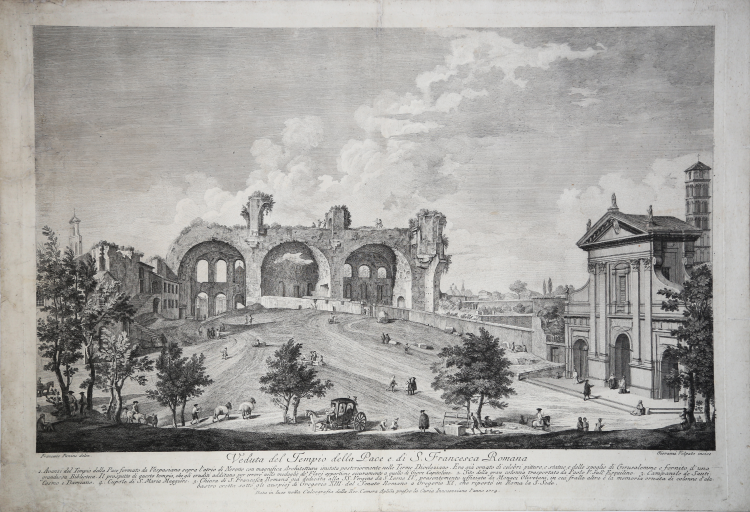




| Reference: | S31317 |
| Author | Giovanni VOLPATO |
| Year: | 1774 |
| Zone: | Tempio della Pace |
| Printed: | Rome |
| Measures: | 700 x 480 mm |



| Reference: | S31317 |
| Author | Giovanni VOLPATO |
| Year: | 1774 |
| Zone: | Tempio della Pace |
| Printed: | Rome |
| Measures: | 700 x 480 mm |
Large view engraving by Giovanni Volpato, after Francesco Panini, representing the Temple of the Peace and the church of Santa Francesca Romana.
The work belongs to a series of views of Rome printed in the second half of the 18th century at the behest of Panini, who availed himself of the collaboration of the best engravers of the time: Vasi, Antonini, Barbazza, Cigni, Montagu, Polanzani, Volpato and many others. The plates are printed by the Calcografia of Reverenda Camera Apostolica.
Francesco Panini or Pannini (Rome 1738 - April 10, 1800) trained with his father Giovanni Paolo (Piacenza, 1691 - Rome, 1765) and continued the activity of vedutistica devoting himself in particular to the realization of refined works on paper. In fact, the scarce critical attention dedicated to him, betrays the real historical importance of the painter, who is to be considered among the best interpreters of eighteenth-century graphics. His production, in fact, while perpetuating a precise tradition manages to express a real renewal in a neoclassical key. Proving to be an able perspective artist, Panini was praised by Mariette and the authors of the 'Vignola illustrato' Giambattista Spampani and Carlo Antonini counted him among the few illustrious perspective artists and as an example for the scholars of architecture. But the production of the artist also counts several works in fresco as the decoration of Villa Albani, the main floor of the Palazzo Cesarini Sforza and Palazzo Doria, on behalf of Cardinal Antonio Maria painted in 1794 of the elegant grotesque panels. To him we owe, in all probability, many of the works in public and private collections considered to be of the 'school of Panini' or 'circle of Panini' if not of Panini himself, and this poses no small problem for the artist's catalog even in his mature years.
Contrary to his father Giovanni Paolo, one of the most famous and appreciated 18th century painters, Francesco Panini has been the object of few studies. The paintings and drawings that today are attributed to his hand show views of ancient Rome or of that contemporary to him where elaborate and grandiose architectures are animated by small and elegant figures, just as in the sheet offered here. A series of his watercolors with views of St. Peter's is preserved in the Department of Graphic Arts of the Louvre: among them is the same depiction of the main facade of the Vatican basilica, albeit with a closer point of view.
Etching and engraving, printed on contemporary laid paper, with margins, in excellent condition.
Literature
L. Salerno, 'I pittori di vedute in Italia', Rome 1991, pp. 290-291; M. Celeste Cola, 'L'inventario di Francesco Pannini, dipinti, disegni e contorni nello studio di Palazzo Moroni', Pisa 2012, pp. 199-224.
Giovanni VOLPATO (Angarano di Bassano, 1740 - Roma, 1803)
|
Italian engraver. In 1760 he entered the famous copperplate printworks of Giambattista Remondini in Bassano and, under the guidance of Antonio Baratti, learnt the art of engraving and etching. During this early period he engraved, signing himself Jean Renard, four Rustic Capricci after Giovanni Battista Piazzetta, the Four Parts of the World after Jacopo Amigoni, the Four Ages of Man after Andrea Zucchi and the portrait of Giambattista Morgagni. On the invitation of Francesco Bartolozzi, who had noted his talent during a visit to Bassano, he moved to Venice in 1762 and was thus able to refine his technique while maintaining his connection with the Remondini concern as a technical consultant and commercial adviser.
|
Giovanni VOLPATO (Angarano di Bassano, 1740 - Roma, 1803)
|
Italian engraver. In 1760 he entered the famous copperplate printworks of Giambattista Remondini in Bassano and, under the guidance of Antonio Baratti, learnt the art of engraving and etching. During this early period he engraved, signing himself Jean Renard, four Rustic Capricci after Giovanni Battista Piazzetta, the Four Parts of the World after Jacopo Amigoni, the Four Ages of Man after Andrea Zucchi and the portrait of Giambattista Morgagni. On the invitation of Francesco Bartolozzi, who had noted his talent during a visit to Bassano, he moved to Venice in 1762 and was thus able to refine his technique while maintaining his connection with the Remondini concern as a technical consultant and commercial adviser.
|